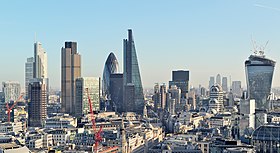Economy of the United Kingdom

The City of London is the financial hub of the UK.
|
|
| Currency | Pound sterling (GBP) |
|---|---|
| 6 April – 5 April | |
|
Trade organisations
|
European Union, OECD, AIIB and World Trade Organization |
| Statistics | |
| GDP | $2.861 trillion (nominal; 2017) $2.757 trillion (PPP; 2016) |
| GDP rank | 5th (Nominal) / 9th (PPP) |
|
GDP growth
|
|
|
GDP per capita
|
$42,106 (nominal; 13th; 2016) $42,041 (PPP; 27th; 2016) |
|
GDP by sector
|
Agriculture: 0.6% Construction: 6.4% Production: 14.6% Services: 78.4% (2014 est.) |
|
RPI: |
|
| 0.25% | |
|
Population below poverty line
|
15% (2014 est.) |
|
|
|
|
Labour force
|
31.85 million (January 2017) (Employment rate 74.6%, record high.) |
|
Labour force by occupation
|
Agriculture: 1.5% Industry: 18.8% Services: 79.7% (2011 est.) |
| Unemployment | 4.7%, 1.56 million (February 2017) |
|
Average gross salary
|
£26,500 / $34,000 annual, 2016 |
| £21,100 / $27,000 annual, 2016 | |
|
Main industries
|
List
|
| 7th (2017) | |
| External | |
| Exports |
|
|
Export goods
|
List
|
|
Main export partners
|
2015: |
| Imports |
|
|
Import goods
|
List
|
|
Main import partners
|
2015: |
|
FDI stock
|
Inward: Outward: |
|
|
|
|
Gross external debt
|
|
|
|
|
| Public finances | |
|
|
|
|
|
|
| Revenues | £716 billion (2015–2016 FY) $1.030 trillion (2016 est. CIA-WFB) |
| Expenses | £772 billion (2016–2017 FY) $1.111 trillion (2016 est. CIA-WFB) |
| Economic aid | 0.7%, $19.0 billion (2015) (donor) |
|
Standard & Poor's: AA (domestic) AA (foreign) AA (T&C Assessment) Outlook: Negative Moody's: Aa1 Outlook: Negative Fitch: AA Outlook: NEGATIVE |
|
|
Foreign reserves
|
|
The United Kingdom is the fifth-largest national economy in the world measured by nominal gross domestic product (GDP) and ninth-largest in the world measured by purchasing power parity (PPP), comprising 4% of world GDP. It is the second-largest economy in the European Union by both metrics. The UK is one of the strongest EU countries in regards to GDP growth, job creation and unemployment.
In 2015, the UK was the ninth-largest exporter in the world and the sixth-largest importer, and it had the second-largest stocks of inward foreign direct investment and outward foreign direct investment. It is one of the most globalised economies, and is composed of (in descending order of size) the economies of England, Scotland, Wales and Northern Ireland.
The service sector dominates the UK economy, contributing around 78% of GDP; the financial services industry is particularly important, and London is the world's largest international financial centre.Britain's aerospace industry is the second- or third-largest national aerospace industry depending on the method of measurement. Its pharmaceutical industry plays an important role in the economy and the UK has the third-highest share of global pharmaceutical research and development. Of the world's 500 largest companies, 26 are headquartered in the UK. The British economy is boosted by North Sea oil and gas production; its reserves were estimated at 2.9 billion barrels in 2015, although it has been a net importer of oil since 2005. There are significant regional variations in prosperity, with South East England and North East Scotland being the richest areas per capita. The size of London's economy makes it the largest city by GDP in Europe.
...
Wikipedia
